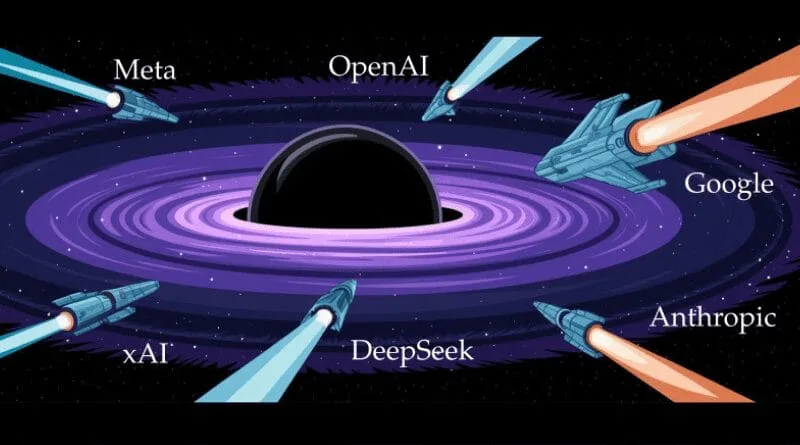Is the Google era over after the rise of ChatGPT and OpenAI’s intelligence?

Will artificial intelligence, such as ChatGPT, force major search engines like Google to retire?
This doesn’t seem realistic or logical, especially now or in the near future. Major search engine companies realized the importance of AI early on and developed it, leveraging their massive databases to develop large language models (LLMs) and advanced AI systems, such as those used by Google.
Search here will be more accurate and better able to understand your questions and the answers you need.
AI will search for answers to your question across a large number of websites and present you with a set of questions related to the topic if you want to delve deeper.
Here are the most popular AI models, how they have contributed to the development of online search, and their advantages and disadvantages.
The Most Popular Large Language Models in AI Search
The following models are the driving force behind many of the generative search and conversational applications we see today, and which are relied upon by a large number of people:
GPT
(Generative Pre-trained Transformer) from OpenAI
The most popular are: GPT-3, GPT-3.5, and GPT-4o which is the latest and most advanced.
The GPT family is one of the most influential and widespread models. It is known for its superior ability to understand and generate human-generated text, answer questions, write articles, and generate code.
The GPT-4o model is multimodal, meaning it can process text, image, audio, and even video inputs.
Gemini
from Google (Google DeepMind)
The most popular are: Gemini 1.0 and Gemini 1.5 which features very long contextual capabilities.
It is Google’s leading multimodal model, specifically designed for multimodal reasoning and long-context tasks. Gemini is already integrated into several Google products, such as Search (Search Generative Experience (SGE), YouTube, Drive, and Android.
Claude
from Anthropic:
Most popular: Claude 3 and Claude 3.5 Sonnet the latest and most advanced version.
Claude models focus heavily on security, helpfulness, and adherence to values. They are known for their ability to understand complex contexts and generate useful responses, and are often used in applications that require high accuracy and reliability.
Llama
from Meta:
Most popular: Llama 2 and Llama 3, which are various versions such as 8B and 70B.
These models are open source, meaning developers and researchers can access and modify their core code. They are cost-effective and offer strong performance across various benchmarks, making them a popular choice for projects that require greater flexibility.
BERT
(Bidirectional Encoder Representations from Transformers) from Google:
Although older than the generative models mentioned above, BERT was revolutionary in understanding the bidirectional context of language. It is still widely used in search engines to improve understanding of user queries and content classification, even though it is not primarily a generative model.
Advantages of Large Language Models from AI in Search
AI-powered search offers significant advantages during the search process, such as:
- Understanding complex and long queries that involve multiple contexts, rather than simply matching keywords.
- Generating concise and straightforward answers to questions, saving users time.
- Creating new texts, summarizing long documents, or even writing emails and articles based on user requests.
- AI in search makes the search process easier and more natural, like a conversation with a knowledgeable person.
- Newer models, such as Gemini and GPT-4o, can process and understand information from multiple sources, including text, images, audio, and video, significantly expanding the scope of searches.
- Adapting results and answers based on user preferences and search history.
Disadvantages of Large Language Models in Search
Despite their tremendous capabilities, these models still face challenges and drawbacks, the most important of which are:
- Models may produce incorrect or inaccurate information, yet appear convincing and reliable. This poses a significant challenge in the field of search, where accuracy is critical. Because they are trained on massive amounts of data available online, models may reflect existing biases, leading to biased or unfair results.
- These models lack a true understanding of the world. Their answers are based on patterns learned from the training data and may fail to process information not represented in it.
- Training and running these models requires massive computing resources and power, making them prohibitively expensive for many companies.
- It is often difficult to understand how a model arrived at a specific answer (the “black box” problem), making it difficult to verify its accuracy or source.
- If a model is not updated regularly, it may produce outdated information, as its training data has an expiration date.
- Training data may contain sensitive information, and there are concerns about how this data is used and whether the models might reveal private information.
The Google era and the Rise of ChatGPT
Both Google and OpenAI are leaders in AI-powered search, each with unique approaches and capabilities. Here’s a comparison:
Google:
Google offers an “AI Overview” in search results, which are AI-generated summaries of topics with links to information sources. This feature helps users quickly understand information from multiple sources.
It can also do the following:
- Using models like Gemini, Google enhances its search engine’s ability to understand the nuances of language and analyze different types of content simultaneously to provide more comprehensive answers.
- Google’s AI helps plan activities, such as meal or travel plans, with the ability to customize them directly within the search experience.
- The “Deep Search” feature analyzes hundreds of different searches and uses an AI-based inference model to provide a detailed, contextual answer to a question in minutes.
Open AI:

After initially focusing on large language models (LLMs) like GPT, OpenAI is now focusing on integrating search capabilities directly into its products like ChatGPT, making it a direct competitor to traditional search engines. These capabilities offer the following features:
- OpenAI’s AI can now handle longer conversational contexts, enable better analysis of long conversations and reduce duplication of answers.
- It automatically performs multiple searches for complex or difficult questions.
- OpenAI has launched a prototype of new search features called SearchGPT, with the goal of integrating the best of these features directly into ChatGPT in the future.
Large language models are already revolutionizing how we interact with and search for information, but these challenges require ongoing research and development to maximize their use safely and reliably.
Also read:
- the-age-of-ai-agents
- a-self-driving-tesla-taxi-crashes-into-a-parked-vehicle
- a-chinese-humanoid-robot-cooks-using-virtual-reality
- brain-computer-interfaces-when-telepathy-becomes-a-technological-reality




